Is TikTok Safe for Kids? Here’s What Parents Should Know
If you’re the parent of a tween, you’ve no doubt heard of the popular social media app tiktok, a video-sharing platform where users can view, create, and share self-made and recorded videos on the cell phone. the telephones. While the app can be a source of creativity and fun for users, many parents are understandably hesitant to adopt it with the same enthusiasm as their Gen Z counterparts.
As technology continues to evolve, it can be challenging to keep up. Online safety and data privacy issues are top of mind for many parents when it comes to their teens’ participation in tiktok.
Given the growing popularity of the app, and recent media attention regarding alleged privacy concerns, it’s important to understand exactly what your child is consuming and sharing about them online. here’s what you need to know when it comes to your child’s safety on tiktok and what steps you can take to protect your child online.
index
- what is tiktok?
- risks to consider
- security measures to take
- tiktok alternatives for kids
- tap the three dots next to your user profile, then scroll down to digital wellbeing.
- tap family pairing and select whether the phone you’re using belongs to you or your child.
- a qr code will be displayed on your phone. To link your accounts, your child must scan the qr code.
- You can now access and manage the security features of your child’s account.
- screen time management: you can adjust how much time your child can spend on tiktok per day.
- direct messages: You can restrict who can send messages to your child’s account (everyone or just friends) or turn off direct messages altogether. direct messaging is automatically disabled for users ages 13-15.
- Restricted mode: This setting automatically filters content from your child’s feed that may not be appropriate for young audiences.
- Liked Videos: You can adjust who can see the videos your child liked (everyone or just friends).
- Comments: You can control who can comment on your child’s videos (everyone, friends only, or no one).
- suggest account to others: Control whether your child’s account can be recommended to others or not.
- from your child’s device, open the tiktok app.
- go to profile, then tap on the three-dot button to open settings.
- scroll down to digital wellbeing.
- select screen time management.
- tap the red button to turn it on.
- choose and confirm an access code.
- from your child’s device, open the tiktok app.
- go to profile, then tap on the three-dot button to open settings.
- scroll down to privacy and security.
- select who can send you messages.
- choose everyone, friends or away.
- from your child’s device, open the tiktok app.
- go to profile, then tap on the three-dot button to open settings.
- scroll down to digital wellbeing.
- select restricted mode.
- choose “enable restricted mode”.
- choose and confirm your access code.
- if you want your child’s account to be private, turn on private account.
- To prevent other users from suggesting your child’s account, turn off suggesting your child’s account to others.
- To limit the amount of data tiktok collects from your child’s account, turn off personalized ads.
- toggle allow your videos to download.
- twist who can send direct messages to anyone.
- make no one who can react to your videos.
- set who can see photos you like only for me.
- Make no one who can comment on your videos.
what is tiktok?
tiktok is a video sharing platform where users can view, create and share videos taken with cell phones. The content found on TikTok runs the gamut, from lip-syncing and comedic dancing to educational videos on topics like health or politics. the app provides an interactive world of video-based content where users can connect with each other. But as the tiktok craze continues to spread across the globe, many parents are wondering about the safety implications of the app that their kids can’t get enough of, especially if their children are younger.
TikTok’s official age requirement is 13 years old. users between the ages of 13 and 15 have their account set to private by default, which prohibits them from sending private messages and only allows friends to comment on their videos. Only users 16 and older can record live video or use the private messaging feature.
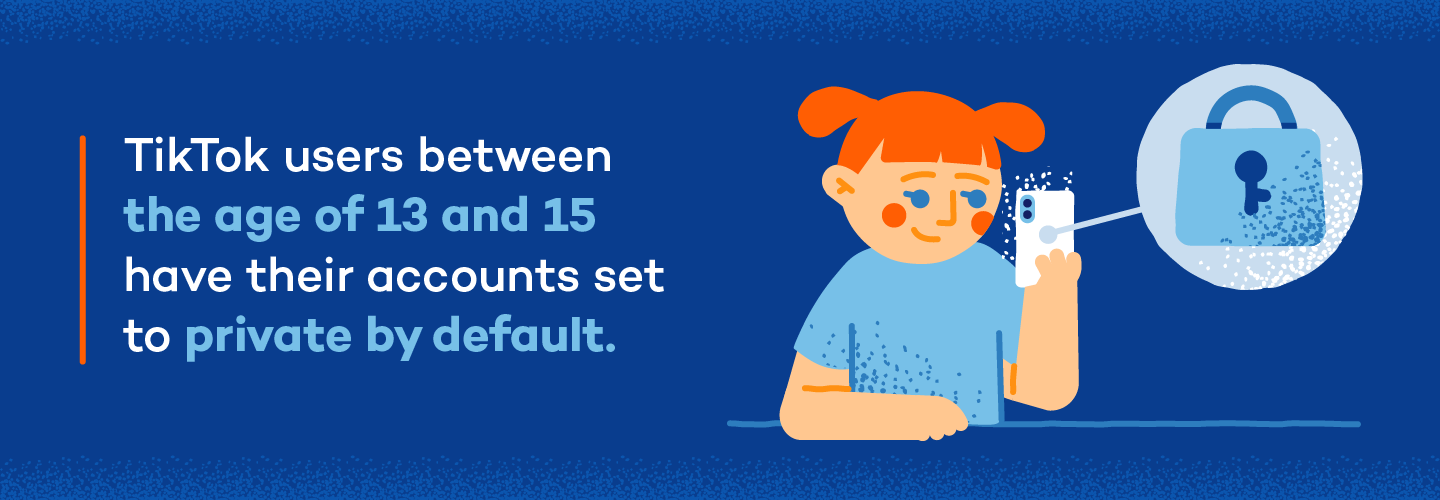
the community associated with the world of tiktok makes it particularly interactive and attractive to users. In addition to creating their own videos, users can follow other creators on the app and interact with their creations through likes, comments, and messages.
Although tiktok has become an entertaining and engaging hobby for many, every social media app carries some level of risk when it comes to online security and data privacy. while most of the content is harmless, there are still some areas of caution to be aware of.
risks to consider
If your child uses tiktok and you’re worried about exactly what they’re getting themselves into, you’re not alone. Educating yourself about the potential security issues associated with tiktok can help you determine whether or not you are comfortable with your child using it. these are the main risks you should know about the application.
exposure to inappropriate content
tiktok is divided into two main feed sections. the “following” feed only shows videos created by the users you follow. the “for you” feed selects a stream of suggested videos based on your account activity and the type of content you typically watch.
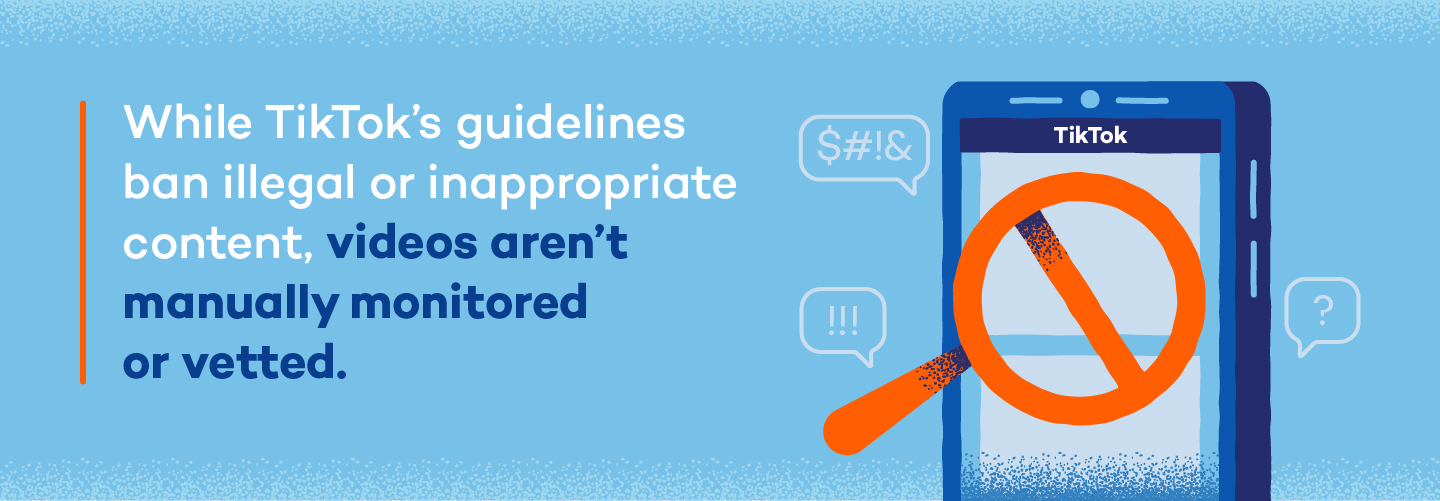 Things can get problematic when it comes to the For You feed, which could end up surfacing videos containing inappropriate content—whether it’s sexually explicit, profane or physically dangerous.
Things can get problematic when it comes to the For You feed, which could end up surfacing videos containing inappropriate content—whether it’s sexually explicit, profane or physically dangerous.
While tiktok’s guidelines prohibit users from sharing illegal or inappropriate content within the app, videos are not manually monitored or vetted. instead, digital algorithms are used to filter out content that violates tiktok’s guidelines. this means that some inappropriate content will inevitably slip through the cracks and find its way onto users’ screens.
contact with strangers
with over 1.1 billion people using tiktok, the potential to communicate with strangers is high. Accounts created by people over the age of 16 are set to public by default, which means that your account activity is visible to anyone. this means that they can communicate with anyone they meet in the app, including strangers. While accounts created by children between the ages of 13 and 15 are set to private by default, this restriction can be easily circumvented by entering a false birth date when signing up for an account.
Having a public account means more than just having your profile and videos visible to anyone on and off tiktok. It also allows suggesting your account to other users within the app, allows anyone to comment on your videos, and allows other users to download your videos. While these settings can be adjusted to allow for more privacy, there will always be the possibility of contact with strangers.
cyberbullying
You probably know that social media and cyberbullying go hand in hand, and tiktok is no exception. Whether it’s strangers sharing their harmful opinions or even comments from friends your child knows in real life, TikTok, like any other social media platform, provides fertile ground for cyberbullying to take root.
A major form of cyberbullying that is increasingly occurring within tiktok is body shaming. Famous tiktok users have spoken about their personal experiences being body-shamed in the comments section of their videos and dealing with a slew of hurtful comments about their body shape and size. this can have far-reaching effects on younger users who are still developing mentally and physically, which can lead to feelings of worthlessness and humiliation.
data privacy
A common concern with any social media platform is the question of how your data is used. the important thing to realize is that while we tend to think of social media platforms as free, technically they are not. advertisers pay them in exchange for companies like tiktok showing their ads to users in the app.
For those ads to be successful and reach their ideal target audience, they need data about those people. this is how tiktok (and many other social media platforms) make money: by selling user data to advertisers.
 With this in mind, parents should understand what data is being collected on their kids and how it’s being used. TikTok gathers your country location, Internet address and the type of device you’re using. With your permission, it can also have your exact location, phone contacts and activity on other social media channels. In addition to your age and phone number, TikTok also has access to any private messages sent within the app.
With this in mind, parents should understand what data is being collected on their kids and how it’s being used. TikTok gathers your country location, Internet address and the type of device you’re using. With your permission, it can also have your exact location, phone contacts and activity on other social media channels. In addition to your age and phone number, TikTok also has access to any private messages sent within the app.
security measures to take
If you want to make sure your child uses tiktok safely, there are several steps you can take. tiktok has a variety of privacy control settings that you can configure from your child’s account that can provide a more secure experience on the app. Please continue reading for an overview of the security settings you can manage on tiktok, along with some additional security precautions you can take to ensure your child stays safe online.
use family pairing
Family pairing mode is a recent addition to the privacy control measures available that you can manage on tiktok. both parent and child must have their own separate tiktok accounts to enable it.
Once enabled, parents can link their account to their child’s and control important privacy settings from their own device. (Previously, parents had to adjust privacy settings within the app on their child’s device.) It’s also password-protected, so unless your child guesses her passcode, they can’t go in and reverse the settings she set.
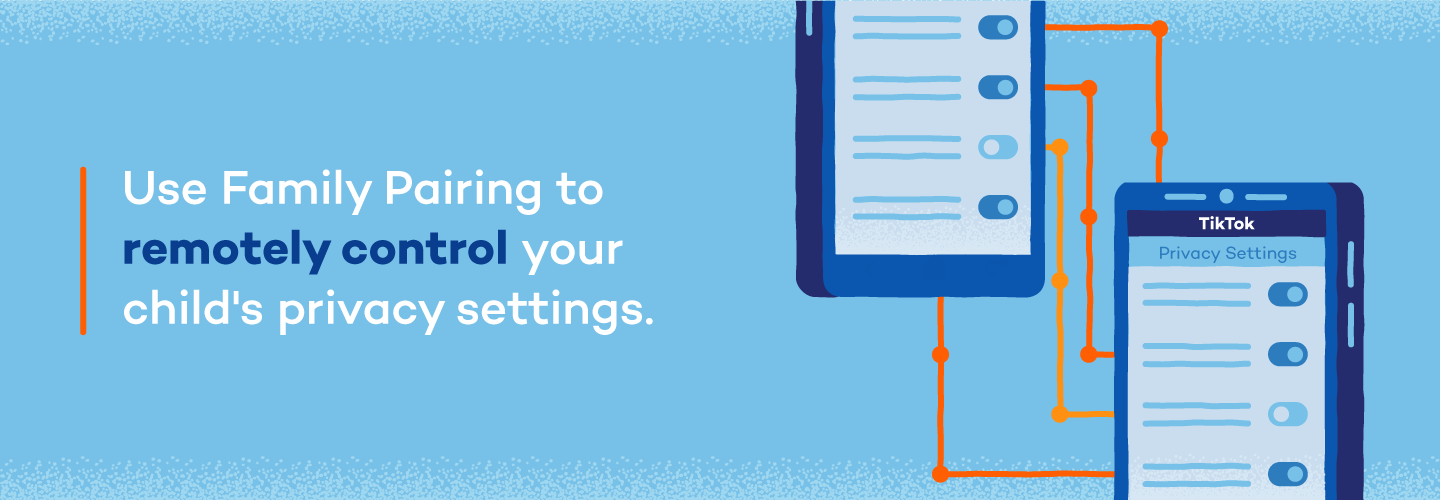 Family Pairing enables parents to manage screen time, direct messaging settings, and the type of content their child can see on the app. To set up Family Pairing, download the TikTok app on your phone and create an account. You’ll also need your child’s phone and their TikTok account logged in and open. Here’s what to do from there:
Family Pairing enables parents to manage screen time, direct messaging settings, and the type of content their child can see on the app. To set up Family Pairing, download the TikTok app on your phone and create an account. You’ll also need your child’s phone and their TikTok account logged in and open. Here’s what to do from there:
here’s some additional information on exactly what you can control with family pairing:
If your child manages to disable family pairing settings, they will receive a notification on their phone to let them know.
control screen time
You can set limits on how much time your child spends on tiktok. While you can manage these settings through the Family Pairing feature, you don’t have to set up Family Pairing to adjust them. Please note that without Family Pairing enabled, you will need to manage these settings from your child’s device. Here’s how to adjust your child’s screen time settings:
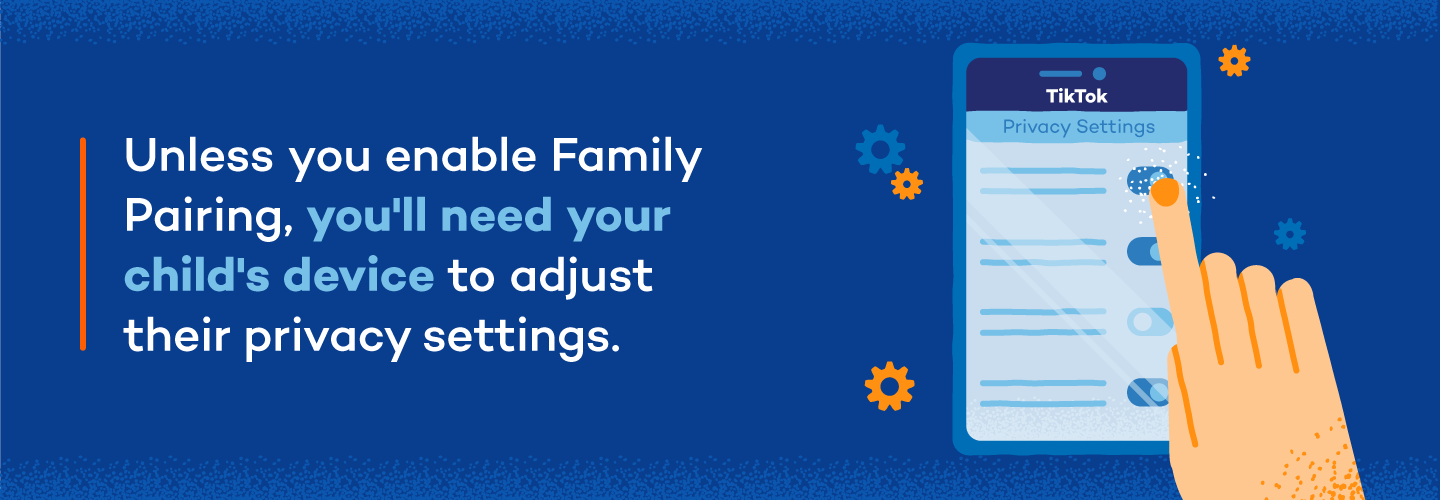
to turn off screen time management, simply repeat steps one through four, then select “turn off screen time management”.
direct messages
You can limit who can send direct messages to your child’s account, or you can turn off direct messages entirely. if you don’t have family pairing turned on, you can still control this setting; you will only have to adjust it directly from your child’s device. this is how this configuration is managed:
activate restricted mode
restricted mode allows you to prohibit inappropriate content from being displayed on your child’s tiktok feed. While you can manage this setting using the Family Pairing feature described above, you don’t have to set up Family Pairing to adjust it. Please note that without Family Pairing enabled, you will need to manage these settings from your child’s device. here’s how to turn on restricted mode:
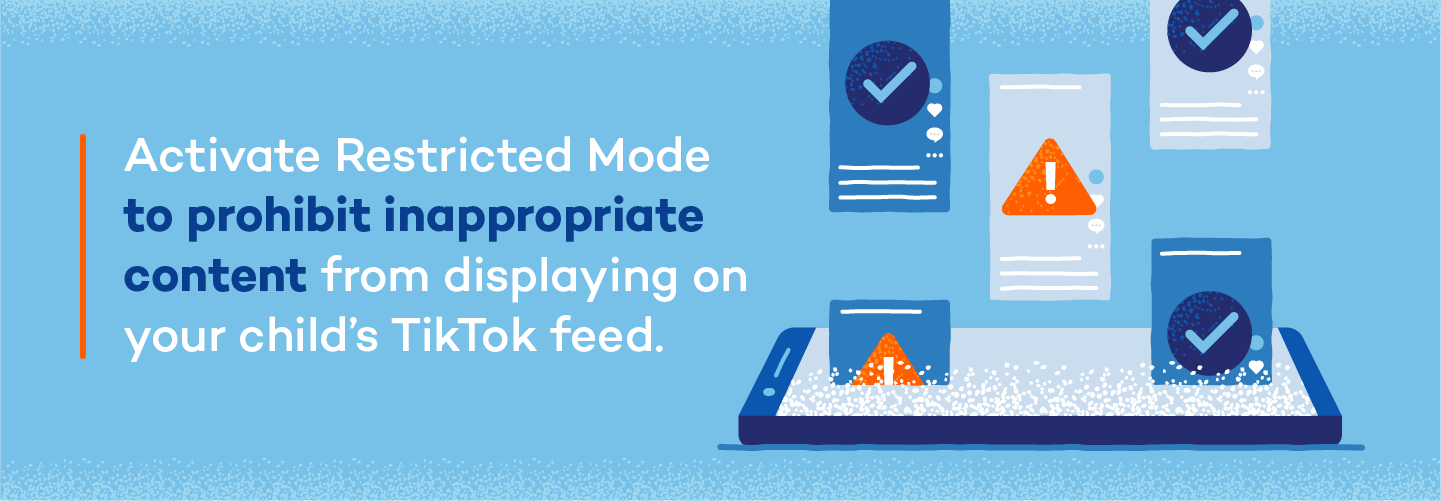
to turn restricted mode off, simply repeat steps one through four, then choose “turn restricted mode off”.
manage interactions
There are many additional privacy settings you can adjust to increase your child’s safety while using the app. you’ll need to adjust them from your child’s device, but you can protect them with a passcode to prevent your child from interfering with the controls you’ve implemented.
To access additional privacy settings, open tiktok on your child’s device. go to your profile, then tap on the three-dot button to open settings. scroll down to privacy and security, then navigate to the following sections to access more settings:
low visibility:
under personalization and data:
under security:
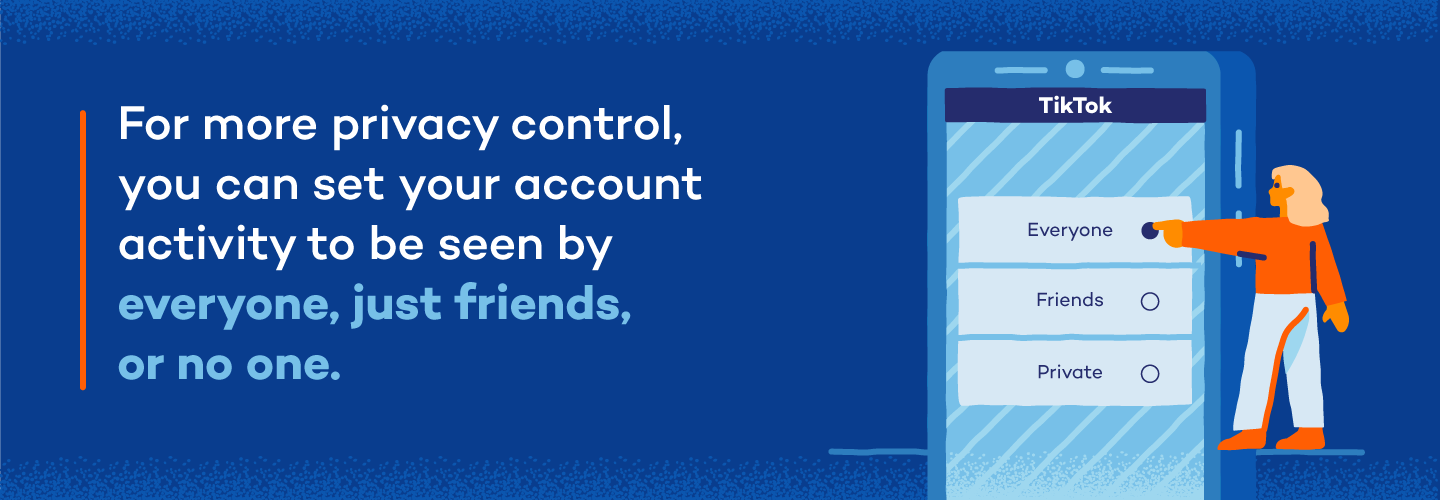
Please note that you will have the option to set these features to everyone, friends, or no one. Choosing the “no one” setting provides the highest level of privacy and security. if you choose the friends setting, it’s a good idea to continually monitor who your child adds to their friends list in the future.
discuss internet safety with your kids
For all the safety measures you can take to protect your children, there’s always the chance that something might slip out. not only that, but children may also try to circumvent the parents’ digital limits and find ways around them. that’s why taking the time to teach your kids about online safety can be one of the most impactful safety measures you can take as a parent.
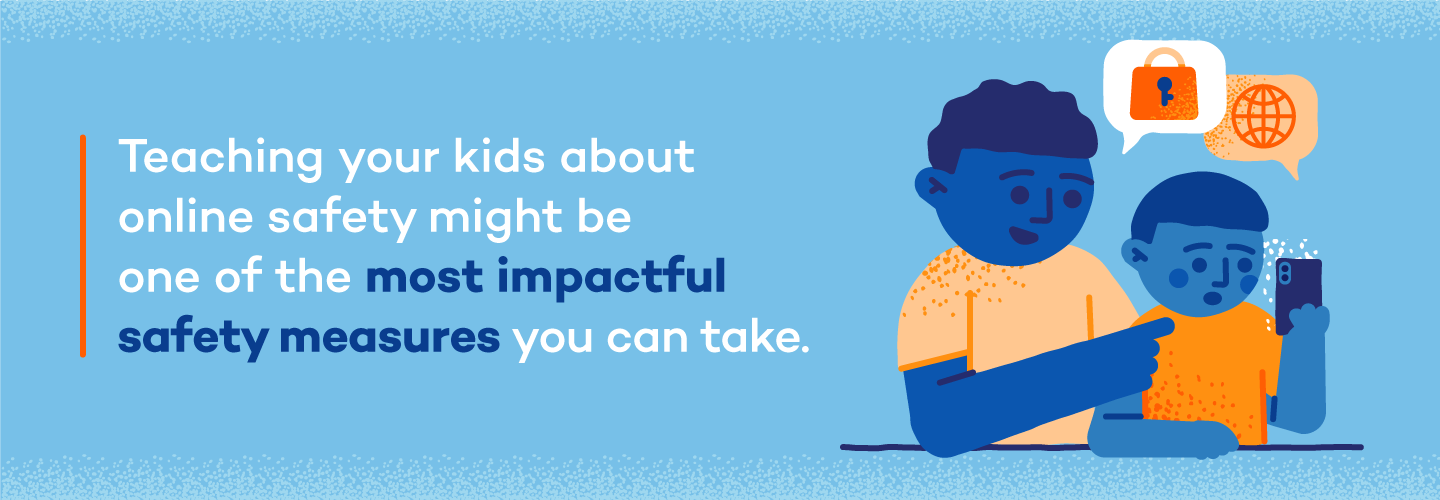 By teaching your children why certain boundaries are put into place and helping them understand the severity of certain dangers that lurk online, they’ll be more equipped to manage their own social media experiences.
By teaching your children why certain boundaries are put into place and helping them understand the severity of certain dangers that lurk online, they’ll be more equipped to manage their own social media experiences.
tiktok alternatives for kids
even after learning about the security measures tiktok offers to make sure your child uses the app safely, you may prefer they don’t use it at all. if this is the case, check out these safer alternatives to tiktok that your child can enjoy instead of tiktok.
dubmash
dubsmash is one of the oldest music video apps, but it got eclipsed by the rise of tiktok. however, with over a hundred million downloads worldwide, its popularity is undeniable. dubsmash allows users to create fun lip sync videos using thousands of different songs and sounds. it also allows you to lip sync quotes from movies and TV. The online community is similar in nature to tiktok in that users post their music videos on their profile and can also view their friends’ videos.
funny
funimate allows users to create a variety of videos: slow motion, compilation videos, looping videos, and much more. The app’s huge music library allows you to include countless popular songs and sound effects in your videos, and you can also add text and stickers to your videos. funimate features over twenty video effects to make creations stand out and allow users to show their creativity.
thresher
triller is a safer alternative to tiktok that allows you to record videos and share them on other social media accounts like twitter, instagram or facebook. The simplicity of the app is what attracts most of the users, including celebrities like Kevin Hart and Selena Gomez. all you have to do is record your footage, and triller’s automatic editing tool does the rest of the work. Users can further edit their videos with the editing tools provided in the app and can use a variety of filters or even draw on the videos for another level of creativity and customization.
With the overwhelming amount of information available and the ever-changing nature of technology, it can be difficult for parents to stay on top of the most important information about the platforms their children use. Knowing which privacy settings you can control and set limits with your children is a great way to keep your child protected from online threats, including malware and data breaches at bay.
Make sure your entire family is protected by keeping antivirus software on all your connected devices and decrease the chances of you or your child falling victim to cybersecurity threats.